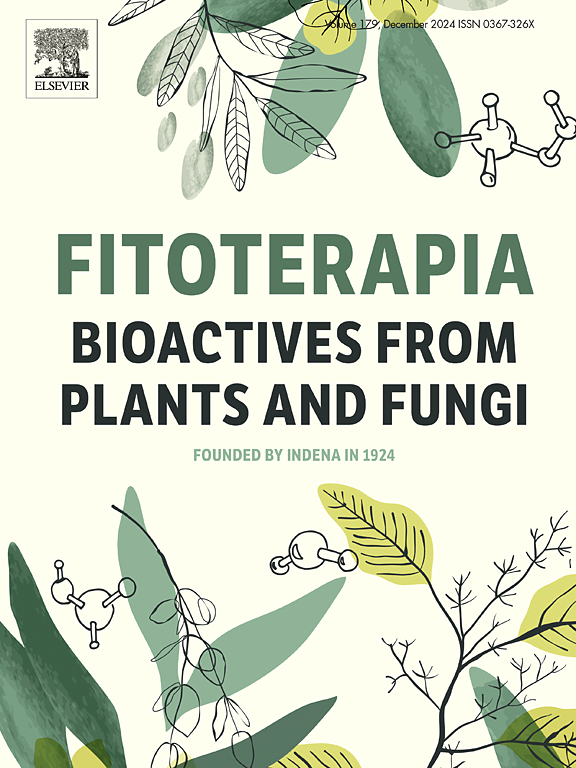Integrated metabolomics and network pharmacology to reveal the mechanism of Wenxiao Jieyu capsule in the treatment of depression
IF 2.6
3区 医学
Q3 CHEMISTRY, MEDICINAL
引用次数: 0
Abstract
This study aimed to explore Wenxiao Jieyu Capsule's (WJC) antidepressant mechanisms via serum pharmacochemistry, network pharmacology, metabolomics, and experimental validation. Serum pharmacochemistry and network pharmacology were employed to predict the biological processes and pathway regulated by WJC. Chronic unpredictable mild stress (CUMS)-induced rat model of depression was to explore the antidepressant mechanisms of WJC. A total of 20 prototype compounds were identified. Network pharmacology identified 283 overlapping targets, showing significant enrichment in purine metabolism and the NOD-like receptor protein 3 (NLRP3) inflammasome pathway. In vivo, WJC improved serum profiles, attenuated CUMS-induced depression-like behaviors and neuronal injury in the prefrontal cortex (PFC). Furthermore, WJC downregulated the expression of purinergic receptors P2X purinoceptor 7 (P2X7R) and adenosine A2A receptor (A2AR), upregulated adenosine A1 receptor (A1R) expression, and inhibited the activation of the NLRP3 inflammasome, as evidenced by decreased protein levels of NLRP3, apoptosis-associated speck-like protein containing a CARD (ASC), and cysteine-aspartic acid protease-1 (Caspase-1). Collectively, these findings indicate that WJC alleviating neuroinflammation in CUMS-induced depressive rats by modulating purine metabolism and suppressing NLRP3 inflammasome activation. It offering a foundation for further research and clinical applications.

结合代谢组学和网络药理学研究温消解郁胶囊治疗抑郁症的作用机制
本研究旨在通过血清药物化学、网络药理学、代谢组学和实验验证等方法探讨温消解郁胶囊的抗抑郁作用机制。采用血清药物化学和网络药理学方法预测WJC调控的生物学过程和途径。研究慢性不可预测轻度应激(CUMS)诱导大鼠抑郁模型,探讨WJC的抗抑郁作用机制。总共鉴定了20个原型化合物。网络药理学鉴定出283个重叠靶点,显示嘌呤代谢和nod样受体蛋白3 (NLRP3)炎症小体途径显著富集。在体内,WJC改善了血清谱,减轻了cms诱导的抑郁样行为和前额皮质(PFC)的神经元损伤。此外,WJC下调嘌呤能受体P2X嘌呤受体7 (P2X7R)和腺苷A2A受体(A2AR)的表达,上调腺苷A1受体(A1R)的表达,抑制NLRP3炎症小体的激活,表现为NLRP3蛋白、凋亡相关斑点样蛋白含CARD (ASC)和半胱氨酸-天冬氨酸蛋白酶1 (Caspase-1)水平的降低。综上所述,这些发现表明WJC通过调节嘌呤代谢和抑制NLRP3炎性体激活来缓解cms诱导的抑郁大鼠的神经炎症。它为进一步的研究和临床应用奠定了基础。
本文章由计算机程序翻译,如有差异,请以英文原文为准。
求助全文
约1分钟内获得全文
求助全文
来源期刊

Fitoterapia
医学-药学
CiteScore
5.80
自引率
2.90%
发文量
198
审稿时长
1.5 months
期刊介绍:
Fitoterapia is a Journal dedicated to medicinal plants and to bioactive natural products of plant origin. It publishes original contributions in seven major areas:
1. Characterization of active ingredients of medicinal plants
2. Development of standardization method for bioactive plant extracts and natural products
3. Identification of bioactivity in plant extracts
4. Identification of targets and mechanism of activity of plant extracts
5. Production and genomic characterization of medicinal plants biomass
6. Chemistry and biochemistry of bioactive natural products of plant origin
7. Critical reviews of the historical, clinical and legal status of medicinal plants, and accounts on topical issues.
 求助内容:
求助内容: 应助结果提醒方式:
应助结果提醒方式:


